Blast from the Past III: Quaking in Fear
In the third part of our look back on '90s shooters, Pete explores the jump to full 3D that eventually led us to where we are now.
This article first appeared on USgamer, a partner publication of VG247. Some content, such as this article, has been migrated to VG247 for posterity after USgamer's closure - but it has not been edited or further vetted by the VG247 team.
As we've already seen in the previous two parts of this series, first-person shooters have a long and interesting history.
Beginning as flat 2D maps projected into 3D and gradually evolving into depictions of environments with a sense of height as well as width and depth, the genre played a significant role in pushing PC gaming forwards, and in showing that home computers were more than capable of competing with consoles in terms of graphically spectacular experiences.
Even as the genre continued to evolve through increasingly complex titles like Duke Nukem 3D and Marathon, however, the tech still kept running into a wall: despite appearances, these games still weren't truly three-dimensional. They were still, for the most part, constructed as a two-dimensional map made of polygons and straight lines, with height maps added to vary the position of floors and ceilings. While this provided a fairly convincing illusion of being in a 3D world, there were limitations, the main one being the fact it was impossible to have rooms above other rooms.
While the developers at 3D Realms, Bungie and numerous others were struggling with this technological limitation of their engines, the wizards at Id Software were working on a completely new way of looking at a virtual world. Id had already popularized and revolutionized the genre with Wolfenstein 3D and Doom respectively, and even prior to its release, it was clear that Quake was going to be something special -- so that's where we'll pick up our story today, just in time for QuakeCon.
Guns and Gibs
On February 24, 1996, a file named QTest appeared, and those in the know were already aware that it was a technology demo for Id's next game. QTest only featured three different maps, was only playable in multiplayer and featured some graphics and gameplay elements that were unfinished, but it demonstrated a number of important things: firstly, that this was the sort of thing we could expect from Quake when it eventually arrived several months later; and secondly, it showed people how the file system and modability of Quake would work.
That latter aspect is particularly important -- the mod scene had been growing ever since the days of Wolfenstein 3D, and had only continued to thrive in the Doom era with a wide variety of custom maps along with graphics and sound mods being distributed via the Internet, other online services such as CompuServe and AOL, and via cover-mounted CDs on magazines.
But Quake, it seemed, was about to take things to a whole new level. Even before the game was released, modders had already edited QTest to incorporate AI-controlled monsters into the otherwise empty levels, and found a means of replacing the default player skins with custom art. The revolution that was Quake was underway.
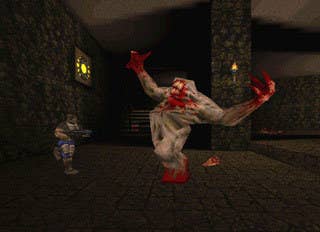
The full version of Quake turned out to be, unsurprisingly, something of a spiritual successor to Doom, blending sci-fi and horror themes together much like its predecessor. While Doom relied on traditional images of Hell and demons, however, Quake took a more Lovecraftian approach, with many level names and monsters lifted directly from Lovecraft's work. The first episode concludes with a boss fight against a Chthon, for example, and the final boss is called Shub-Niggurath, though there's some conjecture that, if we're being picky, it's actually more of a Dark Young. The game was originally intended to incorporate more in the way of Lovecraftian bosses but, as seems to be something of a pattern with Id's early titles, this was scrapped due to time constraints.
Those time constraints were largely due to John Carmack taking on a little too much work at one time. Not only was he working on a brand new engine, he was also working on a TCP/IP networking model that would power the game's multiplayer functionality. Carmack later admitted that it would probably have been beneficial to Quake as a whole to split this into two separate projects.
Still, even knowing that Quake wasn't everything it perhaps could have been, it's still an impressive achievement. The difference between the true 3D of Quake and the fake 3D of Duke Nukem 3D, its contemporary and biggest rival, was immediately obvious. Suddenly Duke's sprite-based enemies looked somewhat primitive compared to Quake's polygon monsters. The fact that levels were constructed as 3D models rather than 2D drawing meant that rooms and passageways could intertwine, weaving around, through, over and above each other, making for some much more interesting level design than was possible in less advanced engines. And the early physics model introduced some peculiar techniques that many people still use in first-person shooters today -- the most recognizable and famous of which is rocket-jumping. Quake also popularized the use of "mouselook," though it didn't invent it -- that honor belongs to Bungie's Marathon, which we explored last time.

The mod scene continued to thrive with Quake, too, because the game had been so obviously written with modifications in mind. The built-in "Quake C" programming language allowed anyone to modify the game as they saw fit, either simply tweaking the way it behaved normally or, in more extreme cases, completely rewriting significant portions of it to provide completely new experiences. The latter became known as "Total Conversions" or TCs, and brought us such diverse experiences as Quess (Chess with Quake monsters as the pieces), Quake Rally (which pioneered the "look in the direction you want to go" vehicle control scheme used in most console first-person shooters today) and AirQuake (a primitive but functional flying game using the Quake engine). Some of these TCs even went on to become fully-fledged commercial products in their own right -- most notable among them were mission packs from Hipnotic Interactive (now Ritual Entertainment) and Rogue Entertainment (who worked on American McGee's Alice, among other things), as well as the officially licensed X-Men TC The Ravages of Apocalypse by Zero Gravity Entertainment.
Single-player Quake was fun, if relatively straightforward once the novelty of the new engine wore off. It was multiplayer that captured and maintained the attention of a worldwide community, though, and helped establish Quake as one of the earliest eSports. It also helped popularize online play, particularly once Id implemented its QuakeWorld update to improve the experience for those still playing on dial-up -- in the mid-'90s, broadband connections were still yet to become widespread in many areas, don't forget.
But Quake wasn't just important in itself; it was also important in that it was the first step on a journey into the future. Whereas the technological limitations of Build and equivalent engines had backed that particular arm of the first-person shooter genre into a corner, Quake's full 3D engine and immensely expandable nature meant that it formed the basis for a significant number of other games that would follow it.
Hack and Slash
One of the most significant variations on Quake came in the form of Hexen II by Raven Software, actually the third game in the Heretic series. This series as a whole was somewhat interesting, since while Heretic was little more than a fantasy-skinned Doom, its sequel Hexen pioneered the use of "hub" levels that would be later revisited in Id's sequel to Quake, along with several different character classes, each with their own abilities.
Hexen II was a significant upgrade once again, and an attempt to address the fact that, over time, some players -- particularly those who didn't have easy access to multiplayer sessions -- had become dissatisfied with Quake's shallow single-player gameplay. Hexen II, meanwhile, maintained the hub-based gameplay of its predecessor while adding a selection of role-playing game mechanics to the mix -- characters would now level up and grow stronger as they gained in experience, and your actions in levels had more permanent consequences. Destructible environments were added, too, and succeeding in the game often demanded you move from one level to another in order to open up various pathways.
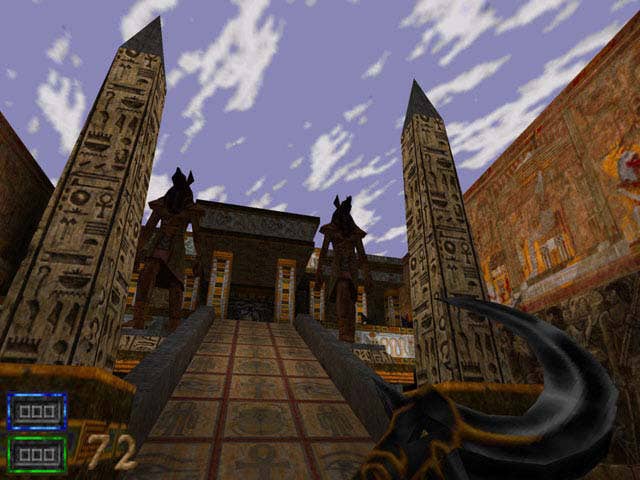
In Hexen II, you travel through four different "continents," each of which has its own distinct theme: medieval European, Mesoamerican, ancient Egyptian and Greco-Roman. The different environments helped counter the recurring complaint that Quake was "too brown" -- yes, people were complaining about that even back in 1996 -- by having greater diversity both in setting and in the enemies that populated each area.
Despite the fact that Hexen II was a distinct experience from Quake -- and arguably considerably better and more interesting in single-player -- it wasn't anywhere near as well-regarded as the game that spawned its engine. In fact, these days it's relatively unknown, though occasionally someone picking up those Id/Bethesda bumper packs that Steam does every so often will stumble across it and discover that it's actually rather a good game. It's perhaps because, despite the new additions it brings to the table, it isn't doing anything especially revolutionary with the technology -- it's simply a solid game built on a pre-existing engine.
Powered by Quake
While the first Quake was one of the most important games ever created, its engine went on to power surprisingly few successors. (That said, one of those successors was tremendously important, but more on that in a moment.)
The same cannot be said for its sequel, however, which spawned one of the most-used game engines of the late '90s.
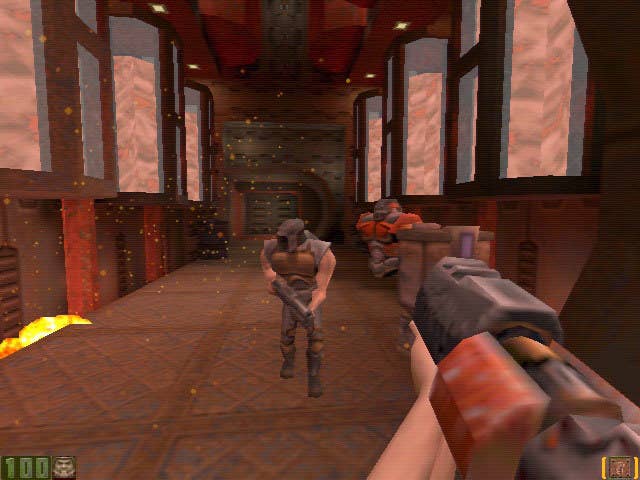
Quake II itself was a good game. It had almost nothing in common with the original Quake, though -- its nomenclature was a result of Id failing to get the rights to the title it wanted to use, so it fell back on the project's codename of Quake II. Taken on its own merits, though, Quake II provided a satisfying sci-fi shooter experience, featuring hub-based levels and objective-based gameplay rather than being a straight dash to the finish. Its enhanced engine, meanwhile, allowed for the use of skyboxes and colored lighting as well as supporting fancy new 3D accelerator cards straight out of the box.
As noted, though, it wasn't necessarily Quake II itself that proved to be noteworthy. Instead, the most influential thing about Quake II was its engine, which went on to power a significant number of subsequent games, all of which added their own little innovations and twists on the basic formula. Raven Software's Soldier of Fortune, for example, became notorious for its violent death animations that responded to where you shot people; Ritual Entertainment's Sin, meanwhile, combined the fast action possible in Quake II's engine with an effort to actually tell a coherent story through the gameplay. Even John Romero's notorious flop Daikatana was based on Quake II's technology, as was Tom Hall's role-playing game Anachronox.
The Golden Year of PC Gaming
Quake II came out just as 1997 was drawing to a close, and helped to usher in what many regard as one of the finest years PC gaming ever saw: 1998.
Take a glimpse through the games released in 1998 and it's easy to see why this year in particular was so fondly regarded: not only were people getting to grips with Quake II and its engine -- Quake II multiplayer remained one of the most consistently popular online games throughout the whole year -- but we also saw the arrival of a number of very significant titles, particularly in the first-person shooter genre.
In May, Epic (then Epic Megagames) released Unreal onto an unsuspecting world. Previously known for high-quality, low-budget shareware games, Unreal marked Epic's bold step into the big leagues. And it was spectacular.
In stark contrast to Quake II, which was largely awash in oranges, yellows and browns, Unreal was a vibrantly colored adventure across an alien world, featuring a combination of exterior and interior environments rendered in then-stunning detail. As well as being impressive to look at, Unreal also introduced us to a storytelling trope now commonly seen in first-person shooters: the fact that the player character is wandering through environments after something has happened, leaving them to piece together their own picture of what went on through reading log entries and other documents scattered around the game world.
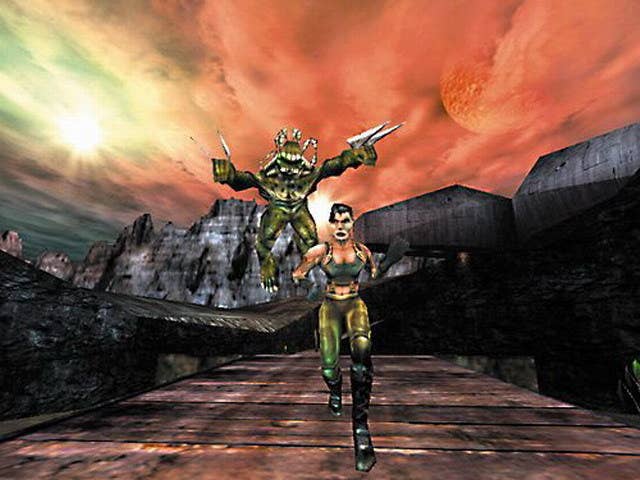
Its engine was also noteworthy for building levels in a distinctly different manner to Quake -- while Quake levels were built using various objects stuck together and then "compiled" into a finished map, Unreal levels were effectively "carved" out of a solid block and did not require compiling. This meant that, while editing, levels could be previewed in real-time, which helped make the difficult task of level building a little more understandable to those who had struggled with Quake's way of doing things.
Unreal was succeeded by Unreal Tournament in late 1999, which helped establish Epic as a major player in the online first-person shooter space, and an official sequel once the 21st century began. Now, the name is known primarily as an engine rather than a game series, but the early installments are still worth playing.
Meanwhile, Looking Glass Studios was working on its own true 3D game engine. Said engine was known as the Dark Engine, named for its first public appearance in Thief: The Dark Project, and later seen in the 1999 classic System Shock 2.
Thief: The Dark Project was a noteworthy game in and of itself, though, because it proved that games unfolding from a first-person perspective didn't have to be all fast action and killing. In fact, Thief was, in many ways, the complete opposite of many of its contemporaries, favoring a much slower pace with an emphasis on hiding in shadows and attempting to make as little noise as possible. While you could probably argue it's not a first-person shooter as such, it was definitely one of the more noteworthy games of 1998, and its stealth mechanics proved to be very influential on future games.
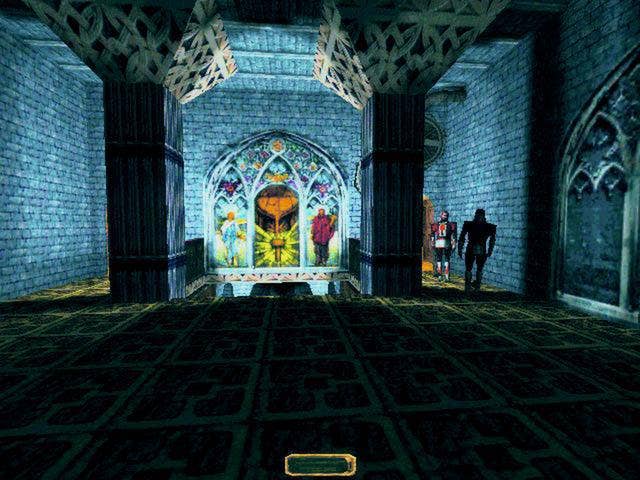
The Dark Engine itself was a noteworthy piece of technology not for its impressive visuals, but for less obvious features. Visually, Thief was on a par with early full 3D first-person shooters like Quake, and some severe technological limitations and a lack of scalability held the engine back significantly. However, it did bring in some interesting new mechanics relating to artificial intelligence and sound propagation: level designers had control over how sound travelled through various environments, and this in turn would inform the AI routines how to respond. Each character could move through three different states besides their normal idle routines -- vague acknowledgement of something out of the ordinary, which simply prompts a bit of "what was that?" dialog; definite acknowledgement, which causes the character to begin actively searching for the player; and definite acquisition, which causes the character to actually attack the player. This system, which sounds relatively simple on paper, made for opponents in the game who behaved in a surprisingly convincing, realistic manner.
By far the most noteworthy game of 1998, though, was Half-Life.
With My Brains and Your Brawn...
Half-Life was the work of a young company called Valve, made up of former Microsoft employees. The company actually had trouble finding a publisher for the game when they first revealed it, with many turning away on the grounds that it was too ambitious a project. It would eventually be Sierra -- previously known for its point-and-click adventures, but a company that had been branching out significantly in the late '90s -- who would take a chance on the game. The huge success of the original Half-Life allowed Valve to go independent for their future titles.
Half-Life's engine is called GoldSrc and is actually a heavily modified version of the original Quake's engine, incorporating a few bits and pieces from Quake II along the way. Valve's addition to the basic engine included skeletal animation -- Quake's animations were built frame-by-frame rather than rendered on the fly -- and support for Direct3D, eventually culminating in approximately 70% of the original code being rewritten. Today's Source engine has its roots in GoldSrc, as the name suggests, but shortly before the release of Half-Life the two engines were split off into separate projects, since the more advanced Source engine was doing significantly more "risky" things for the technology of the time.
Half-Life offers both single and multiplayer gameplay, but unlike many other online-centric first-person shooters, it's the single player component that garnered the most attention. Here was a game that, for once, made an effort to tell a story through its gameplay -- and not through non-interactive cutscenes or collectable logs. Instead, Half-Life brought us the concept of the scripted sequence -- the ability for level designers to trigger cool things happening according to where the player was and what they were doing. This aspect of the game's design is immediately apparent from the outset: the game begins with protagonist Gordon Freeman riding a train into work, wandering around, interacting with colleagues and eventually triggering the disaster that forms the basis for the game's overall plot.

The key thing with Half-Life is that all the way through what is ostensibly the "intro," you're in full control of your character. While on the train, you can move around, look out of the windows and observe things going on around you. When you arrive at Black Mesa, you can talk to people and interact with various items before stepping into the fateful experiment chamber. At no point does the game wrestle control away from the player and say "no, I'm doing this bit" -- you're always directly involved, and it was this that helped make Half-Life and its successors some of the most immersive experiences in all of gaming. Until you got to the ridiculous "alien planet" levels at the end, of course, which somewhat sullied an otherwise consistently excellent game.
The other noteworthy thing about Half-Life is the number of mods it spawned, much like its precursors. Of these, the most noteworthy are probably Valve's own Team Fortress Classic and Deathmatch Classic, the former of which was eventually pinched, prodded and poked almost beyond recognition to become the Source-powered Team Fortress 2. Counter-Strike also began life as a Half-Life mod, eventually becoming so well-known and well-respected that Valve stepped in to assist with development and would eventually buy the rights to the name, leading to a number of commercially released Counter-Strike products.
Half-Life was a massively influential game that still holds up well today, and it's not unfair to say that it is the one game more than any other than influenced the shape of the modern first-person shooter, for better or worse. While technology has improved over time and allowed for ever more spectacular scripted events to happen around the player, few have managed to match Half-Life's perfect balance between affording the player a degree of freedom and railroading them down the pathway along which the story happens.
A Long Road
The first-person shooter genre continues to evolve today, though at a much slower rate than it did throughout the '90s. However, interestingly, we're starting to see a resurgence in the design philosophy of these '90s shooters with the release of titles like Interceptor's Rise of the Triad reboot and the upcoming Shadow Warrior remake, and even in titles like Bulletstorm, which very much focus on early shooters' focus on fun rather than trying to be an interactive action movie.
Across the three parts of this feature, I've given some examples that I've found personally noteworthy over the years, but time and space constraints mean that it's impossible to provide an exhaustive list. So now it's your turn: let's hear what you think were the most noteworthy or memorable shooters of the '90s, and which ones you'd like to see a modern reboot of. Give your thoughts in the comments and notes and if we get enough responses we'll collect them together into a community feature in the near future.
For now, though, I'm off to spend some time with the brand-new Rise of the Triad reboot. The USgamer review is coming soon, so you'll have to wait for that to find out our "official" opinion, but I will say this with regard to it: I haven't played a game like this since 1994.
